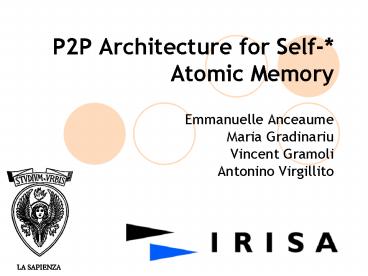P2P Architecture for Self-* Atomic Memory - PowerPoint PPT Presentation
1 / 25
Title:
P2P Architecture for Self-* Atomic Memory
Description:
P2P Architecture for Self-* Atomic ... P2P overlay dynamic quorums replica control Result Multi-Reader/Writer ... Overlay Active replication on a node ... – PowerPoint PPT presentation
Number of Views:50
Avg rating:3.0/5.0
Title: P2P Architecture for Self-* Atomic Memory
1
P2P Architecture for Self- Atomic
Memory
- Emmanuelle Anceaume
- Maria Gradinariu
- Vincent Gramoli
- Antonino Virgillito
2
Goal
- Architecture for Scalable Multi-Reader/Writer
Distributed Shared Memory in P2P Systems
3
Roadmap
- Applications
- There is a solution for each problem
- Modular memory architecture
- Self-Healing mechanism
- Traversing mechanism
- Self-Adjusting mechanism
- Conclusion
4
Applications
- WebServices
- Groupware
w/o cost of maintenance of any centralized
control
5
Peer-to-Peer (P2P)
- Dynamism
- Decentralized
- Unstructured
- Wide-Scale
6
Related Problems
Data Availability
Load
7
Related Problems
Atomic Consistency
Data Availability
Load
8
Dedicated Solutions
Atomic Consistency
Self-Healing
Data Availability
Load
9
Dedicated Solutions
Atomic Consistency
Self-Healing
Self-Adjusting
Data Availability
Load
10
Dedicated Solutions
Dynamic Quorums
Atomic Consistency
Self-Healing
Self-Adjusting
Data Availability
Load
Quorums Mutually intersecting sets
11
Modular Approach
Traversal Module
Dynamic Quorums
Load Balancer Module
Self-Healing
Adjuster Module
Self-Adjusting
12
Single Object Memory
- Atomicity is preserved under object composition.
- The memory is obtained by composition of all
single object memories. - Some nodes have a copy of the same object X the
objects replicas. - We refer to those replicas as the memory of
object X.
13
Architecture
Client
operation
operation-ack
Operation Manager
Traversal Module
Load Balancer Module
Adjuster Module
14
Logical Overlay
The objects responsibility is a CAN torus-grid
shared by replicas. Each replica is responsible
for a part of a virtual domain space 0,1) x
0,1). If two zones are adjacent, their
responsible are neighbors.
operation
Client
operation-ack
15
Bootstrapping Process
Initially, one replica possessed object X. This
is the only responsible of X. Then X is
replicated and responsibility is shared among
replicas. Each replica is responsible for a
part of a virtual domain space 0,1) x
0,1). If two zones are adjacent, their
responsible are neighbors.
16
Self-Healing
failed replica
Overlay
17
Self-Healing
Assuming eventual failure detection. A neighbor
becomes responsible of the failed replicas
zone. The neighbor choice is made by CAN
takeover mechanism.
Overlay
18
Traversing
Consultation quorum set of replicas responsible
of a whole line.
Request receiver
Every propagation quorum intersects every
consultation quorum
Propagation quorum set of replicas responsible
of a whole column.
Overlay
19
Self-Adjusting
overloaded replica
Overlay
20
Self-Adjusting
Overlay
21
Self-Adjusting
Overlay
22
Self-Adjusting
Active replication on a node outside the grid.
Overlay
23
Self-Adjusting
underloaded replica
Overlay
24
Self-Adjusting
Similar to the self-healing mechanism
Overlay
25
Conclusion
- Our approach uses various concepts
- P2P overlay
- dynamic quorums
- replica control
- Result
- Multi-Reader/Writer DSM in P2P Systems
- Only local information is necessary
- Fault tolerance is guaranteed
- Load is balanced
- Operations are atomic
- Future work
- Using mechanism theory for incentive strategy































